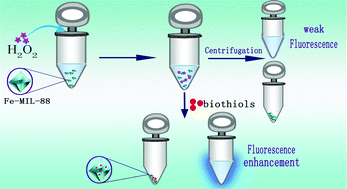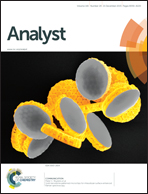A sensitive and selective sensor for biothiols based on the turn-on fluorescence of the Fe-MIL-88 metal–organic frameworks–hydrogen peroxide system†
Abstract
Herein, we present a novel strategy based on a “turn-on” fluorescence system made up of metal–organic frameworks Fe-MIL-88 and H2O2 for detecting biothiols in human serum. The nonfluorescent Fe-MIL-88 gives weak fluorescence in the presence of H2O2. Interestingly, it was found that biothiols such as glutathione (GSH), cysteine (Cys) or homocysteine (Hcy) could induce fluorescence turn-on of the Fe-MIL-88/H2O2 system. Under optimal conditions, the relative fluorescence intensity exhibited a good linear relationship in the range from 50 nM–10 μM for GSH (r = 0.994), 50 nM–10 μM for Cys (r = 0.990), and 50 nM–10 μM (r = 0.992) for Hcy; the detection limits of GSH, Cys and Hcy were 30 nM, 40 nM, and 40 nM respectively. Mechanism investigation reveals that biothiols could associate with Fe-MIL-88 via hydrogen bonding and electrostatic interaction followed by redox reaction between biothiols and Fe3+ present in the Fe-MIL-88, Fe3+ was thus reduced to Fe2+, and then Fe2+ could efficiently catalyze the decomposition of H2O2 to yield ˙OH radicals through the Fenton reaction. Besides, biothiols were able to reduce H2O2 to produce ˙OH radicals directly. Thus the Fe-MIL-88 as well as biothiols could cooperatively contribute to the activation of H2O2 to generate higher amounts of ˙OH radicals, which in turn oxidize the free ligand terephthalic acid (BDC) outside or within the Fe-MIL-88 structure to strongly fluorescent hydroxylated terephthalic acid (OHBDC), thereby turning on the fluorescence.


 Please wait while we load your content...
Please wait while we load your content...